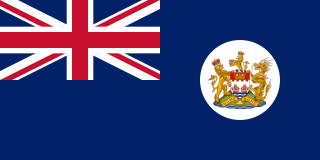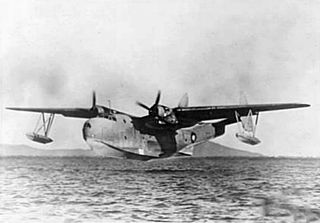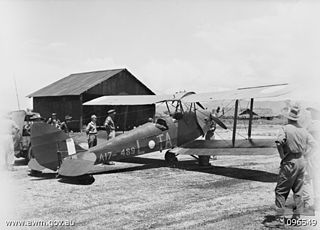This article needs additional citations for verification .(July 2014) (Learn how and when to remove this template message) |
This article needs additional citations for verification .(July 2014) (Learn how and when to remove this template message) |
The first formalised British Commonwealth air dispatch capability dates from the New Guinea campaign of World War II.
"As far as research has resolved, the first airdrops in the New Guinea campaign took place on the 28th of July 1942 at Efogi and Kagi during the withdrawal to Kokoda. In early 1943 Colonel T.G. Millner MC. Deputy Director of Supplies and Transport resolved that air supply was to be an Australian Army Service Corps (AASC) responsibility." [1]
During the Campaign in New Guinea the 1st, 2nd and 3rd Air Maintenance Companies, "The Biscuit Bombers", were formed from members of the Aust Army Service Corps and conducted aerial resupply operations in support of Australian and American Soldiers engaged in fighting Japanese forces. At the end of World War II the air dispatch units were disbanded. A small reserve contingent maintained the capability until reformation in 1960.
Air Despatch Companies were first formed within the British Army's Royal Army Service Corps in March 1944. This was in preparation for the upcoming D day landings and subsequent re-invasion of the European Continent. These companies saw extensive action in Operation Market Garden, the largest airborne operation of all time.
October 1960 saw the raising and training of a Section of Regular Army Air Dispatchers, who formed a regular component of 39 Air Dispatch Platoon (Reserve) at Frenchmans Road Depot in Randwick, Sydney. In order to gain operational experience the Regular Army section of 39 AD Pl. was detached to 55 Company RASC (AD) in February 1961 for duty on the Malaya / Thailand Border. At that time duties of 55 Company RASC (AD) included the resupplying by air of the Commonwealth Brigade in their operations against the Communist Guerrillas. On returning to Australia the Regular Army Section carried out extensive parachute training plus logistic support force supply path finding duties. A second (Regular) Section was formed mid-1961 and detached to 55 Company RASC (AD) for duties on the Malaya / Thailand Border from February to May 1962. Both ARA sections were then sent to Singapore in May 1962 for international Exercise "Trumpeter", this was followed by heavy drop training at the Far East School of Land / Air Warfare. On return from Singapore in July 1962 a Regular Platoon of half strength was formed (40 AD Platoon) at Avoca Street Randwick using the 2 ARA Sections of 39 AD Pl. as the NCO base. [1]
By mid-1963 the unit was at full strength with detachments for operational training to the Malaya / Thailand Border, Singapore and Ubon, Thailand. The formation of HQ 1 Army Air Supply Organisation (HQ 1AASO) in February 1964 saw the rapid expansion of units dedicated to providing Air Transport duties with HQ. 1 AASO Commanding two ARA Platoons (36 and 40 AD Platoons) 36 AD Platoon. being newly formed, three CMF Platoons, namely 37, 38 and 39 AD Platoons, plus five Air Supply Control Sections (ASCS) and an Air Maintenance PI manned by RAAOC personnel. At the same time a joint service (Army / RAAF) unit was raised at RAAF Base Richmond and designated the Air Movement Training and Development Unit (AMTDU). In the 1960s all corps courses were run by this unit for Unit Movement/Enplaning Officers and Unit Air Loading Teams, when "Air Portability" was the catch cry of the times. [1]
During the period 1964 to 1965 with the Indonesian Confrontation on the Papua New Guinea border, AD Sections were positioned in PNG for Air Dispatch duties. By early 1966 1 AASO was fully trained in trade skills (70 percent parachute trained) and Military skills so much so that 36 and 40 Pls. were used as Enemy for the final shake out exercise for 5 RAR in February to March 1966, prior to departure for South Vietnam. It was at this point that the requirement for an AD Unit for South Vietnam was announced and the ARA units were paraded at Gospers Airfield to call for volunteers. Two Officers and 40 Other Ranks were selected to form Det 176 AD Company RAASC.
On the 12 May 1967 the unit was renamed 176 AD Company and was relocated from Vung Tau to Nui Dat, where it remained until the last Air Dispatcher returned to Australia on the 27 February 1972. At this time, while 176 AD Company was the operational unit "in country", the Australian-based unit at Wallgrove, New South Wales was renamed 186 AD Company acting as support. Just after the Vietnam War, Air Dispatch in Australia underwent command structural changes in the form of renaming the 1st Army Air Supply Organisation to the 1st Air Transport Support Regiment.
The Royal Australian Corps of Transport (RACT) was formed on the 1 June 1973 from an amalgamation of several functions from the Royal Australian Army Service Corps (which disbanded) and the Royal Australian Engineers. One of the roles allocated to RACT was the Air Dispatch role.
From the mid-1970s until the mid-1990s 1st Air Transport Support Regiment comprised two air dispatch squadrons: 176 AD Sqn (ARA) and 177 AD Sqn (ARes). The Army Reserve squadron was disbanded in 1994 and reservists transferred to 176 AD Sqn. Also disbanded was 1 ATSR.
176 AD Squadron is now based at RAAF Base Richmond and is a sub-unit of the 9th Force Support Battalion. The Squadron includes a platoon of parachute riggers in addition to the AD troops. The riggers are not members of the RACT, they are members of the RAAOC.
In recent years elements of 176 AD Sqn have deployed to East Timor, the Solomon Islands, and the Middle East.

British Forces Overseas Hong Kong comprised the elements of the British Army, Royal Navy and Royal Air Force stationed in British Hong Kong. The Governor of Hong Kong also assumed the position of the Commander-in-chief of the forces and the Commander British Forces in Hong Kong took charge of the daily deployment of the troops. Much of the British military left prior to the handover of Hong Kong to China in 1997. The present article focuses mainly on the British garrison in Hong Kong in the post Second World War era. For more information concerning the British garrison during the Second World War see the Battle of Hong Kong.

No. 3 Squadron is a Royal Australian Air Force (RAAF) fighter squadron, headquartered at RAAF Base Williamtown, near Newcastle, New South Wales. Established in 1916, it was one of four combat squadrons of the Australian Flying Corps during World War I, and operated on the Western Front in France before being disbanded in 1919. It was re-raised as a permanent squadron of the RAAF in 1925, and during World War II operated in the Mediterranean Theatre. The Cold War years saw the squadron disbanded and re-raised twice. It was based at RAAF Butterworth during the Malayan Emergency and the Indonesia–Malaysia Konfrontasi. Equipped with McDonnell Douglas F/A-18 Hornet multi-role fighters from 1986, the squadron deployed to Diego Garcia in 2002 to provide local air defence, and the following year contributed aircraft and crews to the invasion of Iraq as part of Operation Falconer. In April 2016, it deployed to the Middle East as part of the military intervention against ISIL.
No. 6 Squadron is a Royal Australian Air Force (RAAF) training and bomber squadron. It was formed in 1917 and served as a training unit based in England during World War I. The squadron was disbanded in 1919 but re-formed at the start of 1939. It subsequently saw combat as a light bomber and maritime patrol squadron during World War II, and took part in the New Guinea Campaign and New Britain Campaign before being disbanded after the war.
The Royal Australian Air Force (RAAF) traces its history back to the Imperial Conference held in London in 1911, where it was decided aviation should be developed within the Armed Forces of the British Empire. Australia implemented this decision, the only country to do so, by approving the establishment of the Central Flying School (CFS) in 1912. The location for the proposed school was initially to be at Duntroon, Australian Capital Territory, but in July 1913 Point Cook, Victoria, was announced as the preferred location. The first flights by CFS aircraft took place there in March 1914.

No. 4 Squadron is a Royal Australian Air Force squadron composed of the air force special forces Combat Controllers, aircrew who operate the Pilatus PC-21 aircraft and instructors for the Australian Defence Force Joint Terminal Attack Controller (JTAC) course.

No. 34 Squadron is a Royal Australian Air Force (RAAF) VIP transport squadron. It operates Boeing 737 Business Jets and Bombardier Challenger 604s from Defence Establishment Fairbairn in Canberra. The squadron was formed in February 1942 for standard transport duties during World War II, initially flying de Havilland DH.84 Dragons in Northern Australia. In 1943 it re-equipped with Douglas C-47 Dakotas, which it operated in New Guinea and the Dutch East Indies prior to disbanding in June 1946.

No. 38 Squadron was a Royal Australian Air Force (RAAF) transport and training unit active between 1943 and 2018. It was formed on 15 September 1943 and saw service during World War II transporting supplies and personnel between Australia and the combat zones in New Guinea and Borneo, using Douglas Dakota aircraft. Following the war, the squadron conducted regular courier flights between Australia and Japan in 1947 and 1948. No. 38 Squadron was deployed to Singapore from 1950 to 1952, supplying Commonwealth forces engaged in the Malayan Emergency and undertaking courier flights across Asia. In 1954 it became responsible for training RAAF personnel to operate Dakotas.

No. 5 Squadron was a Royal Australian Air Force training, army co-operation and helicopter squadron. The squadron was formed in 1917 as a training unit of the Australian Flying Corps in Britain, readying pilots for service on the Western Front. It subsequently became a naval fleet co-operation squadron, but was later redesignated as No. 9 Squadron RAAF before being re-formed as an army co-operation squadron during World War II. In the mid-1960s, it was re-formed as a helicopter squadron, before being disbanded in December 1989, when it was used to form the Australian Defence Force Helicopter Training School.

No. 41 Squadron was a Royal Australian Air Force (RAAF) transport squadron of World War II. It was formed in August 1942 and operated flying boats in the South West Pacific area. The squadron was disbanded in September 1945.

No. 40 Squadron was a Royal Australian Air Force (RAAF) transport squadron of World War II. It was formed in March 1944 and operated flying boats between Australia and New Guinea. The squadron was disbanded in June 1946.

ANZUK was a tripartite force formed by Australia, New Zealand and the United Kingdom to defend the Asian Pacific region after the United Kingdom withdrew forces from the east of Suez in the early 1970s. The ANZUK force was formed in Singapore on 1 November 1971 under Rear Admiral David Wells and disbanded in 1974.

No. 15 Squadron was a Royal Australian Air Force (RAAF) light bomber and maritime patrol squadron of World War II. The squadron was formed in January 1944 and initially flew anti-submarine patrols off the east coast of Australia. From September that year elements of the squadron took part in the New Guinea Campaign, and the main body of the squadron moved to New Guinea in March 1945. Its duties in New Guinea included anti-submarine and anti-barge patrols as well as attacking Japanese positions. No. 15 Squadron was demobilised after the end of the war, and was formally disbanded in March 1946.

No. 84 Wing is a Royal Australian Air Force (RAAF) transport wing. Coming under the control of Air Mobility Group (AMG), it is headquartered at RAAF Base Richmond, New South Wales. The wing comprises No. 35 Squadron, operating Aliena C-27J Spartan transport Aircraft; No. 37 Squadron, operating Lockheed Martin C-130J Super Hercules medium transports; and a technical training unit, No. 285 Squadron.

No. 21 Squadron is a Royal Australian Air Force (RAAF) general reserve squadron. Formed in the mid-1930s as a unit of the part-time Citizen Air Force (CAF), it was mobilised for service during World War II, when it saw action against the Japanese as a fighter unit in the Malayan campaign, a dive bomber unit in the New Guinea campaign, and a heavy bomber unit in the Borneo campaign. After the war, the squadron continued to fly until 1960, when the CAF ceased flying operations. At that time, No. 21 Squadron converted to a non-flying support role, which it currently fulfils at RAAF Williams.

The Royal Australian Army Ordnance Corps (RAAOC) is the Corps within the Australian Army concerned with supply and administration, as well as the demolition and disposal of explosives and salvage of battle-damaged equipment. The Corps contains clerks, operator supplies, petroleum operators, parachute riggers and ammunition technicians. Members of the Corps are nicknamed Roaches.

562 Parachute Squadron Royal Corps of Transport (Volunteers) was a minor unit that supported 44th Parachute Brigade (V).

No. 17 Air Observation Post Flight was a Royal Australian Air Force artillery-spotting and liaison unit which saw action as part of the Bougainville campaign and New Britain campaign in World War II. The flight was established in October 1944 and disbanded in December the next year.

No. 10 Local Air Supply Unit was a Royal Australian Air Force air transport unit of World War II. No. 84 Wing was formed on 11 September 1944 in Cairns, Queensland. Commanded by Group Captain Bill Hely, it comprised No. 5 Squadron, No. 17 Air Observation Post (AOP) Flight, No. 10 Communication Unit, and No. 39 Operational Base Unit. The wing arrived at Torokina in October to begin supporting Australian troops during the Bougainville Campaign. 10 Communications Unit flew Avro Ansons and Bristol Beauforts on courier, reconnaissance, supply, and anti-malarial spraying missions; it was renamed No. 10 Local Air Supply Unit RAAF in March 1945. The Unit was also formed at Aitape, New Guinea on 18 April 1945 to undertake the local air supply of Australian Army units in New Guinea. The Unit here was equipped with a mix of Avro Anson, Bristol Beaufort and Tiger Moth aircraft and conducted supply and casualty evacuation flights until the end of the war. When the Pacific War ended in August 1945, No. 10 Local Air Supply Unit was tasked with dropping leaflets announcing the news over Japanese positions. Following the war No. 10 Local Air Supply Unit conducted courier flights to various locations in New Guinea until it was disbanded on 6 March 1946. 17 AOP Flight was disbanded on Bougainville in December, followed a month later by the Bougainville flight of No.

The Royal Australian Corps of Transport (RACT) is a corps within the Australian Army. The RACT is ranked tenth in seniority of the corps of the Australian Army, and is the most senior Logistics corps. It was formed on 1 June 1973 as an amalgamation of the Royal Australian Army Service Corps (RAASC) and Royal Australian Engineers Transportation Service. The RACT is responsible for the operation of army surface transport assets, movement control, terminal and postal services, and Army aspects of air logistic support.

No. 86 Squadron was a Royal Australian Air Force (RAAF) fighter squadron of World War II. The squadron was formed in March 1943 and was deployed to Merauke in Dutch New Guinea in July that year. While No. 86 Squadron was stationed at Merauke until April 1944, it saw little combat. After being transferred back to Australia its aircraft and personnel were transferred to other units, and only a nucleus of the squadron remained. While it was re-equipped with new aircraft in June 1945, the war ended before the squadron was ready for combat and it was disbanded in December 1945.